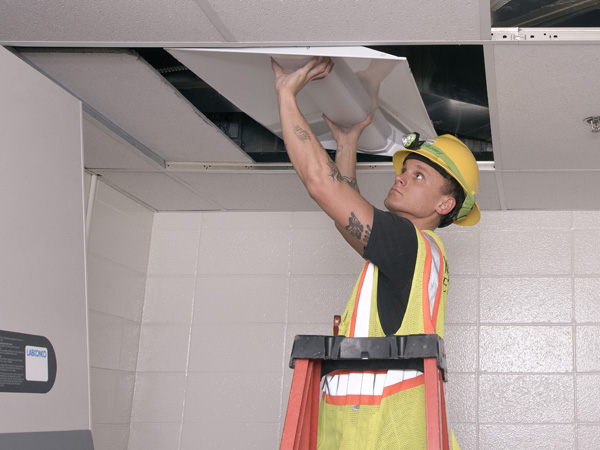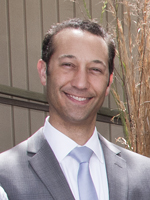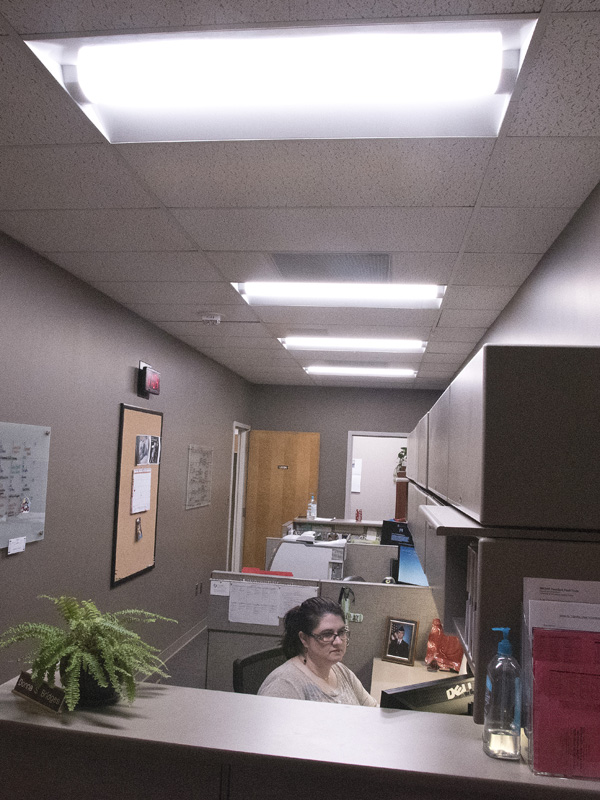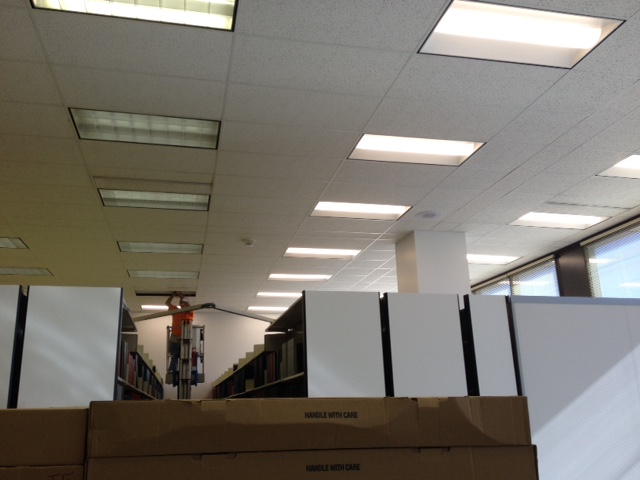LED conversion enlightens UMMC campus

A new energy management initiative is literally shining a new light on efficiency and safety at the University of Mississippi Medical Center.
Funded by the Bureau of Buildings for $820,000 as an Energy Conservation Measure (ECM), the ongoing project is converting outdated T-12 and T-8 fluorescent lights, which consume more energy and produce non-directional light, to Light Emitting Diode (LED) lights, which require less energy and provide directional lighting, in select areas of the Jackson campus.

"LEDs are the future of lighting," said Arthur Jones, construction project manager in the Office of Planning, Design and Construction. He said the initiative originally developed as part of an overall energy management effort to change the lighting infrastructure at various state institutions.
"Initially we were going to switch our T-12s to a more efficient (T-8) fluorescent, but as the project was getting started, LED lighting became more cost-effective to install and maintain," Jones said. "So we skipped over the T-8 fluorescents and went straight to LEDs."
UMMC's Office of Planning, Design and Construction received its official Notice to Proceed with the initiative on Oct. 15, 2014, and began putting digital electric meters in the parking garages to obtain an exact measurement of the energy being consumed there. This winter, the construction office began installing the LED lights in the garages and in the Clinical Sciences Building and breezeway. Exterior lighting surrounding the Emergency Department and two large pylon signs at UMMC's Lakeland and North State Street entrances also received an LED upgrade.
The results have been rather illuminating.

"The lights in the garages were due to be changed," Jones said. "These new fixtures are a visible improvement over what was there. A lot of people have remarked that the garages now have a much stronger light. People in the Clinical Sciences Building have commented how bright it is in their offices.
"It's a better quality of light. LEDs don't flicker."
Coinciding with the lighting conversion by the construction office, the Department of Physical Facilities began a complementary lighting upgrade project in other areas of campus, including the School of Dentistry, the Rowland Medical Library and the Verner Holmes Learning Resource Center.
According to Clifford Galloway, associate director of engineering services who is directing Physical Facilities' LED efforts, the Medical Center should realize a considerable savings from the new light installation project.
He said in hallways and office buildings scheduled for the conversion, existing light fixtures use 80 watts of power; the new LEDs only require 32 watts, roughly a 60-percent savings. He said upgraded lighting in clinical areas will result in even more savings: reducing 160 watts per light to 50 watts per light, or roughly a 70-percent savings.
And that doesn't begin to take into account the new lighting's extended lifespan: LEDs are warranted for seven full years, which drastically reduces maintenance costs, and don't require ballasts, which can generate additional heat.
The first place Galloway's group targeted for conversion was the School of Dentistry building, which required light bulb replacement every year.
"They depended a lot on the quality of lighting," Galloway said. "We were able to retrofit their existing fixtures and started converting them to LED lighting last summer. Initially we upgraded the elevator lobbies, hallways and nonclinical areas first, then worked our way into the clinics.
"The patients have all commented how the building looks whiter, when before, it was kind of dull. It's allowed us to reduce the heat load in the building — which has saved a lot of energy costs — and it's allowed us to reduce maintenance. With all of the savings, they can afford to light all their lights up 24-7."

The Rowland Medical Library, with its 13-and-a-half-foot ceilings, presented a tougher conversion challenge — and required a little salesmanship. Galloway said Susan Clark, associate professor of academic information services and library director, wasn't sold on LED lighting at first.
"With the number of (fluorescent) lights in the library, we would try to go in and address all the areas that had bulbs out," Galloway said. "When we had finished, there would be a new list. There was a constant churn.
"Since we've put in the LEDs, we haven't had the first work order to replace lights in that area. We're getting out of the light bulb business."
That didn't necessarily guarantee that LED lighting would provide the correct light for studying in a library like Rowland, though.
"Susan was receptive to the idea of upgrading the quality of lighting, but she wasn't too sure about LEDs," said Galloway, who noted she was concerned that the lights might exceed what was recommended for a library. "I said, 'Let's put them up and then tell me what you think.' After we started putting them up, she said, 'I didn't know the lighting in the area was so dim. Now I do.'
"They were so used to poor lighting, that when they got something different, it's kind of overwhelming. But we'd finish one area of the library and the students would move over to that area. That tells you the lighting was good."
Clark said her initial reticence had more to do with the quality of light than the quantity. She researched the appropriate standards for lighting clarity in an academic learning environment and, once the LEDs were adjusted to just the right strength and direction, she was on board.
"We had to work to get the right color and shade. We did half a room, and it appeared bright on that side in contrast to the dim light on the other. When they finished, it looked nice.
"Seeing the improved lighting on a larger scale helped me realize the difference and see that the previous light was after all rather dim."
She said as the new School of Medicine building continues to rise directly to the north of the library's main windows, obscuring the sunlight, "I think the LEDs are going to give us the same light and airy feeling we've always had in here. Considering the fact that we are open so many hours, I feel it's the worthwhile thing to do."
Galloway said conversion of the library's lighting will be completed during spring break, while the installation of LED lights will continue in the dental school and in hallways, elevator lobbies and offices in the learning resource center and in the Arthur Guyton Research Center and the School of Health Related Professions building. The School of Medicine and the Translational Research Building, both under construction, will feature LED lighting exclusively.
"We'll continue to assess the areas that need LED conversion and upgrade them as soon as possible," Galloway said. "The quality of lighting is phenomenal compared to what it was — especially in the parking garages — which translates into a much safer environment. We're continuing to look at lighting up the areas of campus that could be hazardous to our patients, visitors and staff.
"We're also in the process of upgrading our external lighting. All spotlights on campus are being converted to LEDs, and we've upgraded flood lights from the Pavilion to the Clinical Science Building."
He described the LED conversion at UMMC as an "ongoing process."
"It may not have come to your area yet, but as renovations are done or as assessments are completed and approved, it's going to grow as time goes on."


